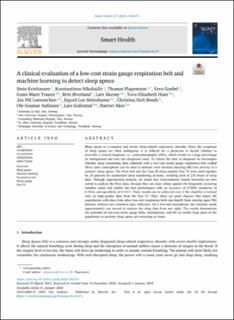| dc.contributor.author | Kristiansen, Stein | |
| dc.contributor.author | Nikolaidis, Konstantinos | |
| dc.contributor.author | Plagemann, Thomas Peter | |
| dc.contributor.author | Goebel, Vera Hermine | |
| dc.contributor.author | Traaen, Gunn Marit | |
| dc.contributor.author | Øverland, Britt | |
| dc.contributor.author | Akerøy, Lars | |
| dc.contributor.author | Hunt, Tove Elizabeth Frances | |
| dc.contributor.author | Loennechen, Jan Pål | |
| dc.contributor.author | Steinshamn, Sigurd Loe | |
| dc.contributor.author | Bendz, Christina | |
| dc.contributor.author | Anfinsen, Ole-Gunnar | |
| dc.contributor.author | Gullestad, Lars | |
| dc.contributor.author | Akre, Harriet | |
| dc.date.accessioned | 2023-10-30T08:38:59Z | |
| dc.date.available | 2023-10-30T08:38:59Z | |
| dc.date.created | 2023-02-02T13:37:12Z | |
| dc.date.issued | 2023 | |
| dc.identifier.issn | 2352-6483 | |
| dc.identifier.uri | https://hdl.handle.net/11250/3099301 | |
| dc.description.abstract | Sleep apnea is a common and severe sleep-related respiratory disorder. Since the symptoms of sleep apnea are often ambiguous, it is difficult for a physician to decide whether to prescribe a clinical diagnosis, i.e., polysomnography (PSG), which results in a large percentage of undiagnosed and very late diagnosed cases. To reduce the time to diagnosis we investigate whether sleep monitoring data collected with a low-cost strain gauge respiration belt (called Flow) and a smartphone can be used to estimate with machine learning (ML) the severity of a patient’s sleep apnea. The Flow belt and the Type III sleep monitor Nox T3 were used together by 29 patients for unattended sleep monitoring at home, resulting each in 235 hours of sleep data. Through experimental analysis, we found that Convolutional Neural Networks are best suited to analyze the Flow data, because they are most robust against the frequently occurring baseline issues and exhibit the best performance with an accuracy of 0.7609, sensitivity of 0.7833, and specificity of 0.7217. These results can be achieved even if the classifier is trained only on high-quality data from the Nox T3. Thus, there are good chances that future ML experiments with data from other low-cost respiration belts can benefit from existing open PSG datasets without new extensive data collection. On a low-end smartphone, the classifier needs approximately one second to analyze the sleep data from one night. The results demonstrate the potential of low-cost strain gauge belts, smartphones, and ML to enable large parts of the population to perform sleep apnea pre-screening at home. | en_US |
| dc.language.iso | eng | en_US |
| dc.publisher | Elsevier | en_US |
| dc.relation.uri | https://www.sciencedirect.com/science/article/pii/S2352648323000016 | |
| dc.rights | Navngivelse 4.0 Internasjonal | * |
| dc.rights.uri | http://creativecommons.org/licenses/by/4.0/deed.no | * |
| dc.title | A clinical evaluation of a low-cost strain gauge respiration belt and machine learning to detect sleep apnea | en_US |
| dc.title.alternative | A clinical evaluation of a low-cost strain gauge respiration belt and machine learning to detect sleep apnea | en_US |
| dc.type | Peer reviewed | en_US |
| dc.type | Journal article | en_US |
| dc.description.version | publishedVersion | en_US |
| dc.source.volume | 27 | en_US |
| dc.source.journal | Smart Health | en_US |
| dc.identifier.doi | 10.1016/j.smhl.2023.100373 | |
| dc.identifier.cristin | 2122341 | |
| dc.relation.project | Norges forskningsråd: 250239 | en_US |
| cristin.ispublished | true | |
| cristin.fulltext | original | |
| cristin.qualitycode | 1 | |

